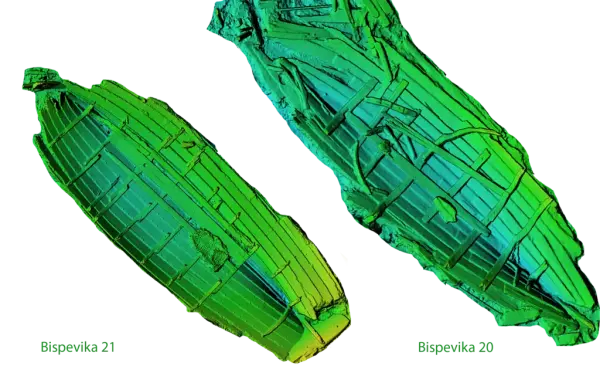- 1/1
3D models of the two shipwrecks Norsk Maritimt Museum | Sjoerd van Riel
In the last couple of weeks, three new shipwrecks have been revealed from the cultural layers in Bispevika, in the central part of Oslos oldest harbour area. The total number of boat finds in 2019 is now six. In this blog post we present some preliminary results and interpretations from the ongoing boat excavation.
Bispevika 20 – a “work horse” in the expanding renaissance harbour
The shipwreck named Bispevika 20 was first discovered in the middle of June, and the excavation took place in the following weeks. As the number in the wreck's name indicate, this is the twentieth shipwreck found in the northeastern part of Bjørvika. The name Bispevika has probably existed since medieval times, and derives from the close proximity to the bishop’s residence in the old part of Oslo.
Bispevika 20 was discovered in direct connection to a timber raft, probably the fundaments and the only remnant of a pier that was constructed here in the mid-16th century. The pier is probably a continuation of the large harbour area excavated on the sites named Barcode B11-B12 and B3-B7, to the north of this year’s dig. Just next to the wreck, and at approximately the same stratigraphical depth, two big wooden anchors was found, but they might not belong to the ship. All finds in the layer surrounding the wreck is dated to the 16th century, which indicates the wrecks age.
The wreck has flattened out on the seabed, and there were boat parts stretching over an area of approximately 9 x 4,5 meters. The boat parts preserved from Bispevika 20 is part of 10 strakes on both sides of the keel, 12 rows of frames, a keel, a keelson and some deck planks. The parts are mainly of oak, while some are of conifer. The strakes were fastened using clinked nails. The wreck has similar traits as some of the wrecks found in the excavation at Barcode B11-B12 and B3-B7. The preliminary results indicates that Bispevika 20 has been a small but compact sailing vessel, seeing how the vessel is relatively wide compared to its length. Maybe this boat served as a «work horse», transporting planks and other trade goods from the piers and to larger sailing vessels moored out in deeper water. The need for middle-sized ships for transport must have been large in the period of expansion for Oslo in the 16th century.
Bispevika 21 – an 18th century extravagant fishing boat?
The shipwreck named Bispevika 21 was discovered a few weeks after Bispevika 20, and the excavation has taken place this week. The ship lies approximately 20 meters west from Bispevika 21. Many of the details documented from this wreck varies from the other wrecks found during the excavations at Barcode B11-B12 and B3-B7, in addition to the five wrecks found at B8a. While the wreck is constructed in the Nordic clinker boat tradition with overlaying strakes, all the nails fastening the strakes in Bispevika 21 are made from wood and not iron. The wreck has nine strakes preserved on the port side and eight on the starboard side. There is also 10 rows of frames, a keel, a stem and a stern posts and some ceiling planks. The boat parts are mostly made of oak, while only a few are made of conifer. Unlike Bispevika 20, Bispevika 21 has a carefully shaped transom. There is also an additional piece by the stem post, probably used as reinforcement. Such support could be beneficial if the boat was towed. Forwards from the center of the boat, there is a small squared mast hole. Inside the wreck there was a nicely preserved fish trap that might belong to the boat.
For now it is not possible to date the layer in which the wreck was found any more accurate than the period between 1624 and the middle of the 19th century. However, the way the wreck was situated in the layer indicates that the boat was built sometime during the 18th century.
The preliminary results presents Bispevika 21 as a small rowing vessel with the possibility to sail. The fish trap can indicate a usage directed towards fishing, but since it is still uncertain if the fish trap actually belongs to the wreck, it is yet undetermined if this has been a fishing boat. The trap might instead have ended in the wreck not long after Bispevika 21 was deposited. There are many details in the construction of this wreck that indicates that some care was put into the finished look of the vessel, demonstrating that Bispevika 21 might not just have been a boat used in everyday work. The placement of the frames in connection to the strakes seems thoroughly planned, there are inscribed lines on the stern post and the wooden nails are very regularly spaced on the strakes. Based on these observations Bispevika 21 might instead be a smaller boat belonging to a large sailing vessel.
Summary
The newly discovered boat wrecks Bispevika 20 and 21 has some similarities in their way of construction, but more striking are the big differences. The two examples show that a variety of boats have been in use, for different purposes, in the Oslofjord in late medieval and early modern period. Further studies of the two boats will extend our knowledge of the construction and usage of small and mid-sized vessels in the historic harbour of Oslo. With the wrecks very good state of preservation, it will be possible to reconstruct the wrecks after their documentation.
While there are a number of wrecks found from the 16th century in Oslo, it is worth noting that the harbour area documented so far is unique in a national setting. The interpretation of the wrecks together with the harbour constructions and all the finds gives an exceptional and nuanced picture of the usage of boats, shipping and life in the harbour of Oslo in the early modern period.
Sources and suggested further reading
Chapman, F. H. 1798: Architectura Navalis Mercatoria. The Classic of Eihteenth-Century Naval Architecture. Dover Publications, Inc. Mineola, New York.
Falck, T., S. Fawsitt og A. Kerr 2016: Sørenga 7: The reconstruction of a 17th century boat from Oslo harbour. INJA.
Gundersen, J. 2012. Barcode Project: Fifteen Nordic Clinker-Built Boats from the 16th and 17th Centuries in the City Centre of Oslo, Norway. Between continents. Proceedings of the Twelfth Symposium on Boat and Ship Archaeology. Istanbul.
Vangstad, H. 2012: Development of an adaptive method for the rescue og 15 shipwrecks from a construction site in Oslo harbor. Need for speed. Between continents. Proceedings of the Twelfth Symposium on Boat and Ship Archaeology. Istanbul.


